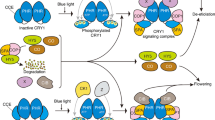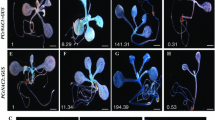Abstract
Cryptochromes are blue-light receptors controlling multiple aspects of plant growth and development. They are flavoproteins with significant homology to photolyases, but instead of repairing DNA they function by transducing blue light energy into a signal that can be recognized by the cellular signaling machinery. Here we report the effect of cry1 and cry2 blue light receptors on primary root growth in Arabidopsis thaliana seedlings, through analysis of both cryptochrome-mutant and cryptochrome-overexpressing lines. Cry1 mutant seedlings show reduced root elongation in blue light while overexpressing seedlings show significantly increased elongation as compared to wild type controls. By contrast, the cry2 mutation has the opposite effect on root elongation growth as does cry1, demonstrating that cry1 and cry2 act antagonistically in this response pathway. The site of cryptochrome signal perception is within the shoot, and the inhibitor of auxin transport, 1-N-naphthylphthalamic acid, abolishes the differential effect of cryptochromes on root growth, suggesting the blue-light signal is transmitted from the shoot to the root by a mechanism that involves auxin. Primary root elongation in blue light may thereby involve interaction between cryptochrome and auxin signaling pathways.







Similar content being viewed by others
Abbreviations
- NPA:
-
1-N-naphthylphthalamic acid
References
Ahmad M, Cashmore AR (1993) HY4 gene of A. thaliana encodes a protein with characteristics of a blue-light photoreceptor. Nature 366:162–166
Ahmad M, Jarillo JA, Cashmore AR (1998) Chimeric proteins between cry1 and cry2 Arabidopsis blue light photoreceptors indicate overlapping functions and varying protein stability. Plant Cell 10:197–207
Banerjee R, Batschauer A (2005) Plant blue-light receptors. Planta 220:498–502
Blilou I, Xu J, Wildwater M, Willemsen V, Paponov I, Friml J, Heidstra R, Aida M, Palme K, Scheres B (2005) The PIN auxin efflux facilitator network controls growth and patterning in Arabidopsis roots. Nature 433:39–44
Brudler R, Hitomi K, Dauyasu H, Toh H, Kucho KI, Ishiura M, Kanehisa M. Roberts VA, Todo T, Tainer JA, Getzoff E (2003) Identification of a new cryptochrome class: structure, function, and evolution. Mol Cell 11:59–67
Chen M, Chory J, Fankhauser C (2004) Light signal transduction in higher plants. Annu Rev Genet 38:87–117
Cluis CP, Mouchel CF, Hardtke CS (2004) The Arabidopsis transcription factor HY5 integrates light and hormone signaling pathways. Plant J 38:332–347
Corell MJ, Kiss JZ (2005) The roles of phytochromes in elongation and gravitropism of roots. Plant Cell Physiol 46:317–323
Falciatore A, Bowler C (2005) The evolution and function of blue and red light photoreceptors. Curr Top Dev Biol 68:317–350
Fankhauser C, Staiger D (2002) Photoreceptors in Arabidopsis thaliana: light perception, signal transduction and entrainment of the endogenous clock. Planta 216:1–16
Friml J (2003) Auxin transport—shaping the plant. Curr Opin Plant Biol 6:7–12
Fujita H, Syono K (1996) Genetic analysis of the effects of polar auxin transport inhibitors on root growth in Arabidopsis thaliana. Plant Cell Physiol 37:1094–1101
Gendreau E, Traas J, Desnos T, Grandjean O, Caboche M, Hoefte H (1997) Cellular basis of hypocotyl growth in Arabidopsis thaliana. Plant Physiol 114:295–305
Gyula P, Schafer E, Nagy F (2003) Light perception and signalling in higher plants. Curr Opin Plant Biol 6:446–452
Hemm MR, Rider SD, Ogas J, Murry DJ, Chapple C (2004) Light induces phenylpropanoid metabolism in Arabidopsis roots. Plant J 38:765–778
Hoecker U (2005) Regulated proteolysis in light signaling. Curr Opin Plant Biol 8:469–476
Jensen PJ, Hangarter RP, Estelle M (1998) Auxin transport is required for hypocotyl elongation in light-grown but not dark-grown Arabidopsis. Plant Physiol 116:455–462
Kiss JZ, Mullen JL, Correll MJ, Hangarter RP (2003) Phytochromes A and B mediate red-light-induced positive phototropism in roots. Plant Physiol 131:1411–1417
Kleine T, Lockhart P, Batschauer A (2003) An Arabidopsis protein closely related to Synechocystis cryptochrome is targeted to organelles. Plant J 35:93–103
Kwok SF, Piekos B, Misera S, Deng XW (1996) A complement of ten essential and pleiotropic arabidopsis COP/DET/FUS genes is necessary for repression of photomorphogenesis in darkness. Plant Physiol 110:731–742
Leyser O (2005) Auxin distribution and plant pattern formation: how many angels can dance on the point of PIN? Cell 121:819–822
Lin C (2002) Blue light receptors and signal transduction. Plant Cell 14:207–225
Mandoli DF, Ford GA, Waldron LJ, Nemson JA, Briggs WR (1990) Some spectral properties of several soil types: implications for photomorphogenesis. Plant Cell Environ 13:287–294
Oyama T, Shimura Y, Okada K (1997) The Arabidopsis HY5 gene encodes a bZIP protein that regulates stimulus-induced development of root and hypocotyls. Genes Dev 11:2983–2995
Partch C, Sancar A (2005) Photochemistry and photobiology of cryptochrome blue-light photopigments: the search for a photocycle. Photochem Photobiol 81:1291–1304
Sakai T, Wada T, Ishiguro S, Okada K (2000) RPT2: a signal transducer of the phototropic response in Arabidopsis. Plant Cell 12:225–236
Sakai T, Kagawa T, Kasahara M, Swartz TE, Christie JM, Briggs WR, Wada M, Okada K (2001) Arabidopsis nph1 and npl1: blue light receptors that mediate both phototropism and chloroplast relocation. Proc Natl Acad Sci USA 98:6969–6974
Sakamoto K, Briggs WR (2002). Cellular and subcellular localization of phototropin 1. Plant Cell 14:1723–1735
Sang Y, Li QH, Rubio V, Zhang YC, Mao J, Deng XW, Yang HQ (2005) N-terminal domain-mediated homodimerization is required for photoreceptor activity of Arabidopsis CRYPTOCHROME 1. Plant Cell 17:1569–1584
Somers DE, Quail PH (1995) Phytochrome-mediated light regulation of PHYA- and PHYB-GUS transgenes in Arabidopsis thaliana seedlings. Plant Physiol 107:523–534
Sullivan JA, Deng XW (2003) From seed to seed: the role of photoreceptors in Arabidopsis development. Dev Biol 260:289–297
Takase T, Nakazawa M, Ishikawa A, Kawashima M, Ichikawa T, Takahashi N, Shimada H, Manabe K, Matsui M (2004) Ydk-1D, an auxin-responsive GH3 mutant that is involved in hypocotyl and root elongation. Plant J 37:471–483
Tanaka SI, Nakamura S, Mochizuki N, Nagatani A (2002) Phytochrome in cotyledons regulates the expression of genes in the hypocotyls through auxin-dependent and-independent pathways. Plant Cell Physiol 43:1171–1181
Toth R, Kevei E, Hall A, Millar AJ, Nagy F, Kozma-Bogar L (2001) Circadian clock-regulated expression of phytochrome and cryptochrome genes in Arabidopsis. Plant Physiol 127:1607–1616
Usami T, Mochizuki N, Kondo M, Nishimura M, Nagatani A. (2004) Cryptochromes and phytochromes synergistically regulate Arabidopsis root greening under blue light. Plant Cell Physiol 45:1798–1808
Wang H (2005) Signaling mechanisms of higher plant photoreceptors: a structure-function perspective. Curr Top Dev Biol 68:227–261
Acknowledgements
We are grateful to Filip Vandenbussche (University of Ghent, Belgium) for helpful comments and critical reading of the manuscript, and to members of the Plant Science Institute at the University of Paris for support and valuable discussion. We acknowledge funding from the CNRS and from the NSF (award #0343737) to M. Ahmad. Roberto Canamero was the recipient of an Erasmus fellowship.
Author information
Authors and Affiliations
Corresponding author
Rights and permissions
About this article
Cite this article
Canamero, R.C., Bakrim, N., Bouly, JP. et al. Cryptochrome photoreceptors cry1 and cry2 antagonistically regulate primary root elongation in Arabidopsis thaliana . Planta 224, 995–1003 (2006). https://doi.org/10.1007/s00425-006-0280-6
Received:
Accepted:
Published:
Issue Date:
DOI: https://doi.org/10.1007/s00425-006-0280-6




